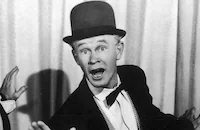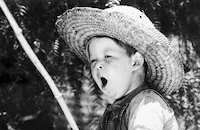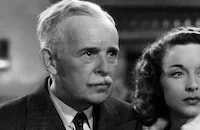Libeled Lady

Brief Synopsis
Cast & Crew
Jack Conway
Jean Harlow
William Powell
Myrna Loy
Spencer Tracy
Walter Connolly
Film Details
Technical Specs

Synopsis
The presses at The New York Evening Star stop too late to kill a false story on heiress Connie Allenbury, so she sues the paper for libel, asking $5,000,000 in damages. Warren Haggerty, the paper's editor, would do anything to get her to drop the suit, although he is happy that it has saved him from finally taking his girl friend Gladys to the altar. Hoping to get themselves out of the suit, Haggerty and the owner, Mr. Bane, reluctantly track down former Star employee Bill Chandler, a specialist in libel cases. Bill tricks Haggerty into a big salary, then plans his strategy: he will marry someone in name only, then pursue Connie and have his "wife" find them in a compromising situation, thereby forcing her to drop the suit. Although she doesn't like the idea, Gladys agrees to marry Bill when Haggerty promises to marry her later. Bill arranges to meet Connie and her father, J. B. Allenbury, and eventually she becomes attracted to him. On a fishing trip, Bill begins to return her affection and he tricks Haggerty and Gladys into postponing the plans. Back in New York, Bill and Connie see each other secretly, while Gladys begins to appreciate Bill's suave attentions. When Haggerty suspects that Bill isn't doing his job, he goes to Connie to plead for the paper and runs into Bill. He then incites Gladys into going through with the plan by printing a false society column linking Bill and Connie. He follows Gladys to a charity carnival they are attending. When Mr. Allenbury hears gossip that Bill may have a wife, he warns Connie, who instead proposes to Bill. When Gladys and Haggerty go to their hotel, they discover that Bill and Connie are married and that he has told her everything. Bill reveals that he had discovered the day before that Gladys' Yucatan divorce from her first husband was not valid and thus her marriage to him was a fake. Gladys, however, says that she got another divorce later in Reno and really is married to Bill. She refuses to let Bill go, but Connie makes her realize that she only fell for Bill because he showed her the little kindnesses that Haggerty didn't. When the women hear the men fighting, Gladys rushes to Haggerty and they make up. Finally, Mr. Allenbury arrives and demands an explanation, which they loudly and simultaneously give him.

Director

Jack Conway
Cast

Jean Harlow

William Powell

Myrna Loy

Spencer Tracy

Walter Connolly

Cora Witherspoon

E. E. Clive
Lauri Beatty
Otto Yamaoka
Charles Trowbridge
Spencer Charters
George Chandler

William Benedict
Hal K. Dawson
William Newell
Greta Meyer

Hattie Mcdaniel

Bud Flanagan
Jack Mulhall
Richard Tucker
Duke York
Harry Allen
Pat West
Ed Stanley
Wally Maher
Pinky Parker
Harry Lash
Pat Somerset
Tom Mahoney
Buster Phelps

Bobs Watson
Tommy Bond
Libby Taylor
Jed Prouty
Eric Lonsdale
Olaf Hytten

Charles Irwin
Eddie Shubert
George Davis
Thomas Pogue

Howard C. Hickman
James T. Mack
Nick Thompson
Ines Palange
Harry C. Bradley
Bodil Ann Rosing
Barnett Parker
Robin Adair
Charles Croker-king
Myra Marsh
Crew
Harold Adamson
Tom Andre
Dr. William Axt
Joseph E. Bernard
Norbert Brodine
Walter Donaldson
Cedric Gibbons
William A. Horning
Hugh Hunt
George Oppenheimer
Howard Emmett Rogers
Douglas Shearer
Fredrick Y. Smith
Wallace Sullivan
Dolly Tree
Maurine Watkins
Lawrence Weingarten
Edwin B. Willis

Photo Collections
Videos
Movie Clip



Trailer
Hosted Intro
Film Details
Technical Specs

Award Nominations
Best Picture
Articles
Libeled Lady
From a professional standpoint, Libeled Lady marked a return to the kind of brassy comic leads that had made her a star. Harlow had campaigned for more diverse roles, and was happy to play Spencer Tracy's working-class wife in Riffraff (1935), Clark Gable's faithful girl Friday in Wife vs. Secretary (1936) and a World War I singer involved with Cary Grant in Suzy (1936). But the last film was the only one to perform strongly at the box office. And though critics had liked her acting, particularly in Wife vs. Secretary, they were clamoring for the return of the old Harlow. So she gladly doffed her brassier and spit comic insults at co-stars Tracy and Powell in Libeled Lady, scoring one of the biggest hits of her career.
Harlow and her co-stars were helped a great deal by a solid script that took the usual screwball comedy formula and doubled it. Instead of one squabbling couple, the film presented two: Tracy and Harlow as a newspaper editor and his perennially jilted fiancee, and Powell and Myrna Loy as an out-of-work reporter and a society girl. The excuse for these frantic couplings and uncouplings is a lawsuit Loy files when Tracy's paper calls her a home wrecker. To get out of the suit, Tracy hires Powell to marry Harlow then lure Loy into an engagement.
In addition to getting a great film, Harlow got top billing in what the studio was advertising as their first all-star film since Dinner at Eight. In addition, just before production started, studio head Louis B. Mayer gave her a $5,000 bonus, primarily in recognition of the surprising profits on her previous film, Suzy, which had brought in three times its cost.
Shooting Libeled Lady was a breeze. The four stars were all friends, and Powell even gave up his old habit of hiding out in his dressing room between scenes so he could join in the fun with the rest of the cast. One of the biggest jokes was a running gag Tracy played on Loy, claiming that she had broken his heart with her recent marriage to producer Arthur Hornblow, Jr. He even set up an "I Hate Hornblow" table in the studio commissary, reserved for men who claimed to have been jilted by Loy.
Although Harlow was delighted to be working with off-screen love Powell, she didn't share much screen time with him. But she often visited the set when he was filming his scenes with Loy. One of those times, while she was waiting for Powell to finish a scene so they could go to dinner, director Jack Conway realized that he was one extra short for a big scene. Rather than let them postpone shooting - the casting office was already closed for the night - Harlow put on a black wig and joined the rest of the extras, a return to the work she had done when she first arrived in Hollywood.
Libeled Lady earned $2.7 million at the box office and landed an Oscar nomination for Best Picture. And it made Harlow a bigger star than ever. With Norma Shearer's career slowing down and Greta Garbo and Joan Crawford labeled box-office poison, she was on her way to becoming MGM's top female star. The studio had just arranged a profitable loan-out for her to star in In Old Chicago (1937) at 20th Century-Fox and had bought a story about a traveling chorus girl named Maisie for her. But she would only complete one more film at MGM - Personal Property - before her untimely death at the age of 26.
Producer: Lawrence Weingarten
Director: Jack Conway
Screenplay: Maurine Watkins, Howard Emmett Rogers, George Oppenheimer
Based on a story by Wallace Sullivan
Cinematography: Norbert Brodine
Art Direction: Cedric Gibbons, William A. Horning
Music: Dr. William Axt
Principal Cast: Jean Harlow (Gladys Benton), William Powell (Bill Chandler), Myrna Loy (Connie Allenbury), Spencer Tracy (Warren Haggerty), Walter Connolly (James B. Allenbury), Charley Grapewin (Hollis Bane), Cora Witherspoon (Mrs. Burns-Norvell), Hattie McDaniel (Maid in Hall).
BW-99m. Closed captioning. Descriptive Video.
by Frank Miller

Libeled Lady
Libeled Lady on DVD
The star power in Libeled Lady is on display straight from the opening titles, under which we see Jean Harlow, Spencer Tracy, Myrna Loy, and William Powell striding arm-in-arm toward the camera. There is no casting-against-type; all of the headliners play to their particular strengths, and what is wrong with that? The plot freely mixes public deceptions, romantic frustrations and battle-of-the-sexes motifs, and still has room to throw in such cliched comedic situations as newsroom chaos and shipboard seduction! Somehow, there is room for all of the plot machinations and nothing seems overly contrived.
Warren Haggerty (Tracy) is a workaholic newspaper editor who all too cheerfully skips out on his wedding to eternal fiancee Gladys Simpson (Harlow) in order to deal with an emergency at the paper: It seems a story has been printed labeling wealthy heiress Connie Allenbury (Loy) as a husband stealer. The story is false, so Allenbury and her father (Walter Connolly) slap the paper with a libel suit for 5 Million dollars. Haggerty concocts a plot to have Connie seen in a compromising situation with a married man to negate the lawsuit. He enlists crafty ex-newspaperman Bill Chandler (William Powell) to charm and seduce Connie during a ship voyage. Since Chandler has to be a married man, Haggerty improbably talks Gladys into the in-name-only nuptials. Of course, the ensuing complications are many: Bill seems to be charming Connie¿s father more than Connie; Gladys despises Bill at first but eventually falls for him as well; and Haggerty seems to be continually digging himself into a deeper hole both romantically and professionally.
MGM assigned contract director Jack Conway to Libeled Lady. A director since the earliest days of filmmaking, Conway was a good choice to handle the variety of styles and settings required of the script. He had previously handled some hard edged big-budget MGM pictures such as Hell Below (1933) and Viva Villa! (1934), and had already worked with Jean Harlow on one of her best career-establishing roles in Red-Headed Woman (1932). Conway¿s touch is evident in some of the rowdier moments of Libeled Lady, notably the on-location sequence of the refined Powell - totally out of his element while trying to fish in a rugged trout stream. Following this film, Conway directed Saratoga (1937), the movie Harlow was making at the time of her death. He also directed Powell and Loy in another of their non-Thin Man comedies, Love Crazy(1941).
It would have been interesting to hear some behind-the-scenes production stories on the Libeled Lady DVD. (For starters, Powell and Harlow, so convincing as a reluctant couple in the movie, were actually engaged in real life at the time of filming). Sadly, this DVD release is a no-frills affair, and has no commentary track or making-of documentary. The only features are a trailer and a cheat of a radio production called Leo On the Air, a promotional broadcast with audio excerpts from the film instead of a live radio production of the story. A further problem with the DVD is the poor quality of the source print used. It is full of blemishes in the form of white splotches (indicating dirt on the negative) and intermittent lines. At times the print damage is downright distracting. While it may not be as essential as The Philadelphia Story or Bringing Up Baby, Libeled Lady deserves an eventual upgrade in DVD quality, whenever a better print surfaces or a restoration is funded.
For more information about Libeled Lady, visit Warner Video. To order Libeled Lady, go to TCM Shopping.
by John M. Miller
Libeled Lady on DVD
Quotes
I thought that was rather clever of me.- Bill Chandler
Yes, I thought you thought so.- Connie Allenbury
She may be his wife, but she's engaged to me!- Warren Haggerty
Trivia
Notes
According to contemporary news items, Lionel Barrymore was originally cast in the role taken over by Walter Connolly. A pre-release news item in Hollywood Reporter lists Mickey Rentschler, Dickie Walters and Mickey Kuhn as children in the cast, but their participation in the completed film has not been confirmed. According to another news items in Hollywood Reporter, Jean Harlow was forced to stay out of the production for ten days due to a severe case of sunburn poisoning, and portions of the film were shot on location in Sonora, CA. Libeled Lady was nominated for an Oscar in the Best Picture Category and was one of the top twenty box-office successes of the year. The film was remade by M-G-M in 1946 under the title Easy to Wed, directed by Edward Buzzell and starring Van Johnson, Esther Williams, Keenan Wynn, and Lucille Ball.

Miscellaneous Notes
Released in United States 1936
Released in United States November 1972
Released in United States 1936
Released in United States November 1972 (Shown at FILMEX: Los Angeles International Film Exposition (Tribute to Myrna Loy) November 9-19, 1972.)

















